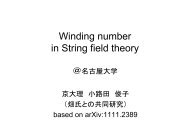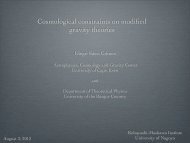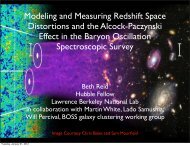Tsujikawa, Phys. Rev. D 77, 023507 (2008)
Tsujikawa, Phys. Rev. D 77, 023507 (2008)
Tsujikawa, Phys. Rev. D 77, 023507 (2008)
You also want an ePaper? Increase the reach of your titles
YUMPU automatically turns print PDFs into web optimized ePapers that Google loves.
(4) Solar system constraintsf(R) gravity[Bertotti, Iess and Tortora,Nature 425, 374 (2003).]・Equivalent[Chiba, <strong>Phys</strong>. Lett. B 575, 1 (2003)]Brans-Dicke theorywith ω BD =0[Erickcek, Smith and Kamionkowski, <strong>Phys</strong>. <strong>Rev</strong>. D 74, 121501 (2006)][Chiba, Smith and Erickcek, <strong>Phys</strong>. <strong>Rev</strong>. D 75, 124014 (2007)]However, if the mass of the scalar degree of freedom Mis large, namely, the scalar becomes short-ranged, it hasno effect at Solar System scales.M = M(R)‘‘Chameleon mechanism’’・ Scale-dependence:ω BD : Brans-Dicke parameterObservational constraint: |ω BD | > 40000Cf. [Khoury and Weltman, <strong>Phys</strong>. <strong>Rev</strong>. D 69, 044026 (2004)]The scalar degree of freedom may acquire a large effective massat terrestrial and Solar System scales, shielding it fromexperiments performed there.No. 15










